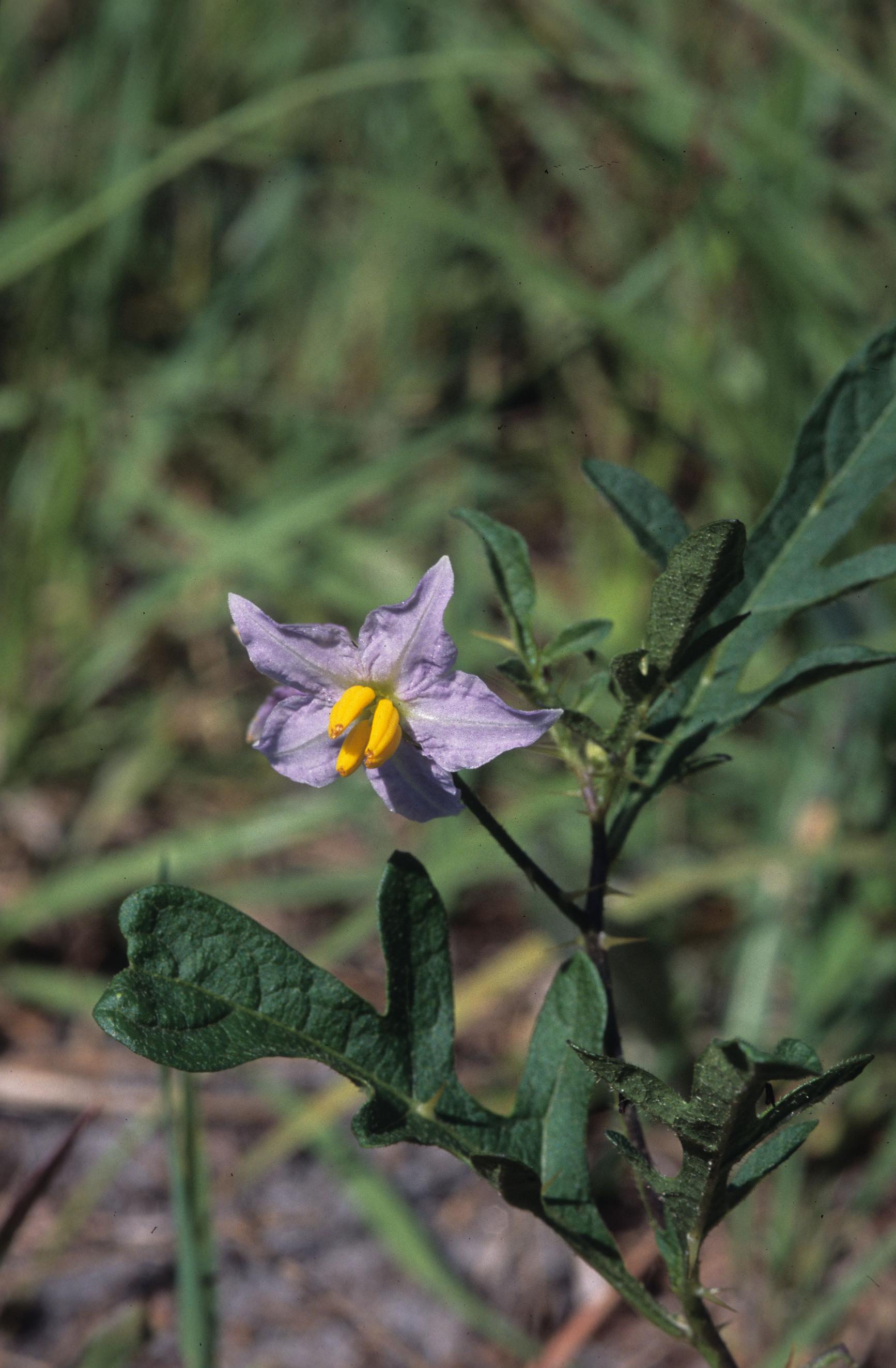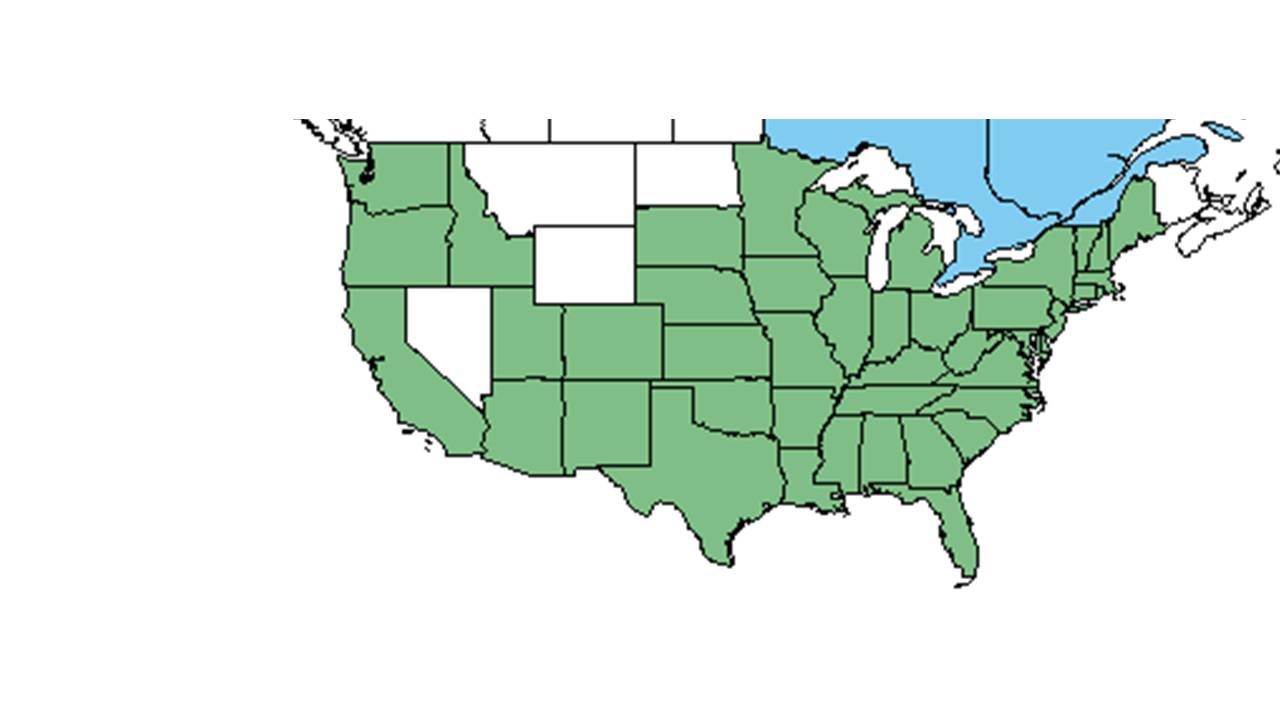Solanum carolinense
| Solanum carolinense | |
|---|---|

| |
| Photo was taken by Gil Nelson | |
| Scientific classification | |
| Kingdom: | Plantae |
| Division: | Magnoliophyta – Flowering plants |
| Class: | Magnoliopsida – Dicotyledons |
| Order: | Solanales |
| Family: | Solanaceae |
| Genus: | Solanum |
| Species: | S. carolinense |
| Binomial name | |
| Solanum carolinense L. | |

| |
| Natural range of Solanum carolinense from USDA NRCS Plants Database. | |
Common names: Carolina horsenettle, Horsenettle
Contents
Taxonomic notes
Synonym: none
Variety: Solanum carolinense Linnaeus var. carolinense; Solanum carolinense Linnaeus var. floridanum (Shuttleworth ex Dunal) Chapman
Description
"Annual or perennial herbs or vines, often armed. Leaves petiolate, entire to pinnatifid. Corolla rotate, 5 parted, the lobes spreading or reflexed. Anthers exserted, erect and connivent or sometimes spreading, opening by two terminal pores, filaments short, often pubescent. Berry 2-locular, mealy or fleshy."[1] "Erect, armed, weakly branched, stellate pubescent perennial, 2-8 dm tall. Leaves ovate to elliptic-lanceolate, 7-12 cm long, 3-8 cm wide, irregularly sinuate, lobed, or parted, both surfaces beset with sessile, stellate trichomes with 5-7 spreading rays and an elongate central ray. Racemes terminal, few-flowered; calyx tube 2-3 mm long, calyx lobes acuminate, 3-6 mm long depending on age; corolla white to purple, 2.3-3.1 cm broad, lobes ovate, spreading or reflexed; anthers erect, connivent, 7-9 mm long. Berry yellow, 1-1.5 cm in diam."[1]
Distribution
Ecology
Habitat
S. carolinense can be found in pinelands, floodplains, floodplain clearings, pine-oak woods, upland oak-hickory forests, grassy turf of berms, pine-palmetto flatwoods, wet hammocks, deciduous woodlands, river banks, bordering marshes, and seasonally wet depressions within thickets.[2] It can also occur at boat landings, roadsides, shrubby lake margins, cultivated watermelon fields, under bridges, roadside depressions, cultivated flower beds, powerline corridors, old fields, along hiking trails, disturbed slash pine woodlands, and cowpea fields.[2] Soils include sandy soils, limestone, sandy loam, loamy sand, alluvial sands, black organic clay[2] and calcareous soils.[3]
Associated species include Richardia scabra, Croton glandulosus, Ambrosia artemisifolia, Datura stramonium, Phytolacca, Amaranthus, Cyperus, Passiflora, Rubus, Ilex, Baccharis, Myrica, horsemint, morning glory, and evening primrose.[2]
Phenology
S. carolinense has been observed to flower and fruit April through November with peak inflorescence in May.[2][4]
Seed dispersal
This species is thought to be dispersed by consumption by vertebrates.[5]
Fire ecology
S. carolinense dominated the canopy coverage on herbicide-treated plots during the first year after treatment.[6] Populations have been known to persist through repeated annual burning.[7]
Herbivory and toxicology
Solanum carolinense has been observed to host bee species such as Bombus impatiens (family Apidae), beetles such asDiabrotica undecimpunctata (family Chrysomelidae), and plant bugs from the Miridae family such as Lygus lineolaris and Spanagonicus albofasciatus.[8] It is an important summer food for bobwhites.[9]
Conservation, cultivation, and restoration
Cultural use
The plant has a variety of uses, and in early America was used as a daily tetanus treatment. The berries can be used for pain relief, anxiety, and promote urination. The entire plant is used for epilepsy, asthma, bronchitis, and seizure treatment. The root of the plant can be considered a sedative.[10]
Photo Gallery
References and notes
- ↑ 1.0 1.1 Radford, Albert E., Harry E. Ahles, and C. Ritchie Bell. Manual of the Vascular Flora of the Carolinas. 1964, 1968. The University of North Carolina Press. 932. Print.
- ↑ 2.0 2.1 2.2 2.3 2.4 Florida State University Robert K. Godfrey Herbarium database. URL: http://herbarium.bio.fsu.edu. Last accessed: July 2015. Collectors: John B. Nelson, Loran C. Anderson, Gwynn W. Ramsey, Richard S. Mitchell, Robert K. Godfrey, John Morrill, Bruce Hansen, Angus Gholson, Jr., Nancy Caswell, S. W. Leonard, Kathy Craddock Burks, Kristen Coleman, Sarah Braun, Stacy Halpern, Andre F. Clewell, R. Komarek, R. F. Doren, ,-- Sherman, ,-- Shamblee, Geo M. Merrill, R. L. Lazor, N. C. Henderson, R. Kral, A Traverse, A. E. Radford, Nora E. Mullens, C. Leland Rodgers, J. B. Nelson, Windler, Keenan, Carl Blomberg, Norlan C. Henderson, Richard D. Houk, W. G. D'Arcy, Paul L. Redfearn, Jr., George T. Jones, Rufus Crane, H F.L. Rock, Roomie Wilson, Wm. H. Ellis, J. Cohn, WM D Countryman, Billy Bailey, Sidney McDaniel, Gerould Wilhelm, L. B. Trott, J. M. Kane. States and Counties: Alabama: DeKalb. Arkansas: Pulaski. Florida: Escambia, Franklin, Gadsden, Gulf, Jackson, Jefferson, Leon, Liberty, Madison, Nassau, Okaloosa, St. Johns, Taylor, Wakulla, Washington. Georgia: Chattahoochee, Grady, Thomas. Illinois: Lawrence, Porter. Louisiana: Lincoln, Ouachita, Tangipahoa. Maryland: Harford. Massachusetts: Bristol. Michigan: Allegan. Mississippi: Amite. Missouri: Barton, Bates, Buchanan, Douglas, Greene, Lafayette, Lincoln, Ozark, Shannon. Ohio: Delaware, Erie. South Carolina: Anderson, Greenville, Richland. Tennessee: Anderson, Cumberland. Texas: Harris, Van Zandt. Vermont: Washington. Compiled by Tall Timbers Research Station and Land Conservancy.
- ↑ Engle, D. M., M. W. Palmer, et al. (2000). "Influence of late season fire on early successional vegetation of an Oklahoma prairie." Journal of Vegetation Science 11: 135-144.
- ↑ Nelson, G. PanFlora: Plant data for the eastern United States with emphasis on the Southeastern Coastal Plains, Florida, and the Florida Panhandle. www.gilnelson.com/PanFlora/ Accessed: 13 DEC 2016
- ↑ Kirkman, L. Katherine. Unpublished database of seed dispersal mode of plants found in Coastal Plain longleaf pine-grasslands of the Jones Ecological Research Center, Georgia.
- ↑ Madison, L. A., T. G. Barnes, et al. (2001). "Effectiveness of fire, disking, and herbicide to renovate tall fescue fields to northern bobwhite habitat." Wildlife Society Bulletin 29: 706-712.
- ↑ Platt, W.J., R. Carter, G. Nelson, W. Baker, S. Hermann, J. Kane, L. Anderson, M. Smith, K. Robertson. 2021. Unpublished species list of Wade Tract old-growth longleaf pine savanna, Thomasville, Georgia.
- ↑ Discoverlife.org [1]
- ↑ Jones, J. D. J. and M. J. Chamberlain (2004). "Efficacy of herbicides and fire to improve vegetative conditions for northern bobwhites in mature pine forests." Wildlife Society Bulletin 32: 1077-1084.
- ↑ Korchmal, Arnold & Connie. 1973. A Guide to the Medicinal Plants of the United States. The New York Times Book Company, New York.